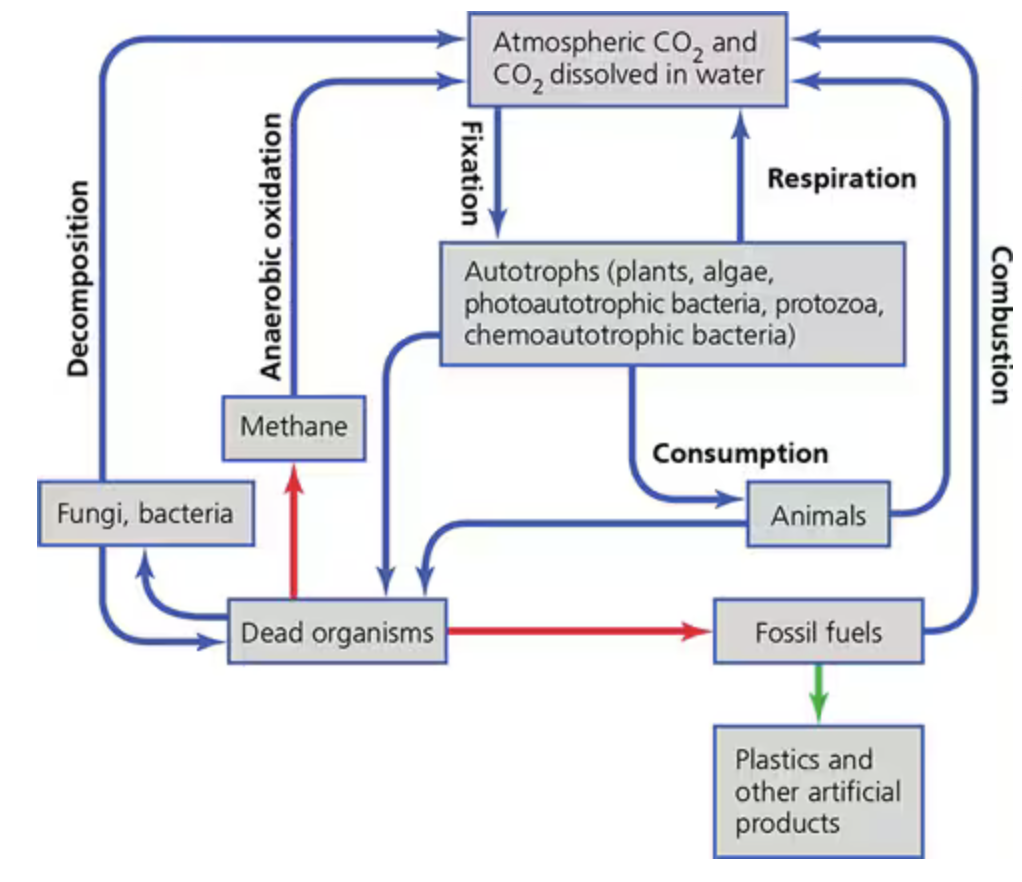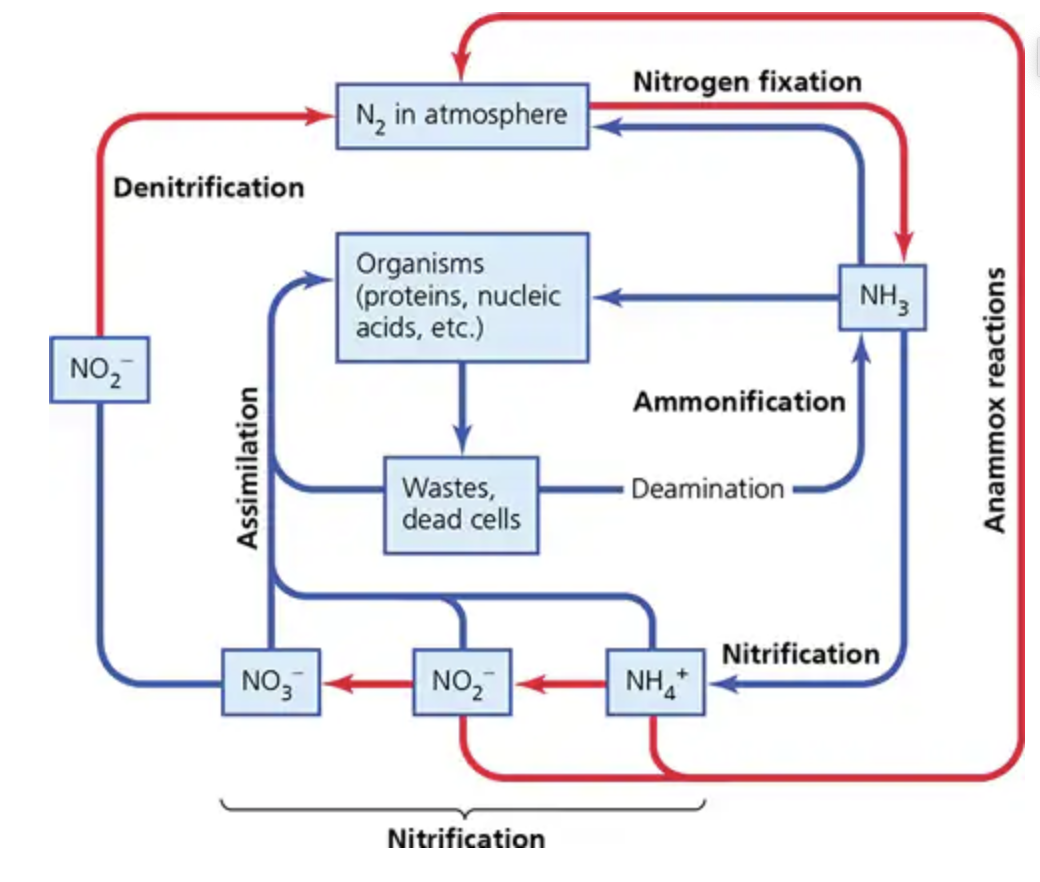Chapter 27: Microbial Ecology and Microbiomes
1/46
There's no tags or description
Looks like no tags are added yet.
Name | Mastery | Learn | Test | Matching | Spaced |
|---|
No study sessions yet.
47 Terms
Define environmental microbiology.
The study of microorganisms as they occur in their natural habitats
Define habitats.
The physical localities in which organisms are found
Define microbial ecology.
The study of the interactions of microorganisms among themselves and their environment
Define biodiversity.
The number of species living in a given ecosystem
Define biomass
The quantity of all organisms in a given ecosystem
Define population.
All the members of a single species in a location
Populations of microorganisms performing metabolically related processes make up groups called guilds
Define microbiome (community).
All the microbes in a particular environment
Define microhabitats.
Specific small spaces where conditions are optimal for survival
Populations and guilds within a community reside in their own distinct microhabitats
Groups of microhabitats form habitats where microorganisms interact with larger organism and the environment
Define ecosystem.
All of the organisms living in a particular habitat and the relationships between the two
Define biosphere.
The region of Earth inhabited by living organisms
All ecosystems together make up biosphere
What is an example of competition?
Microbial growth can be held in check by competition
The best-adapted microorganisms have traits that provide them advantages in nutrient uptake, reproduction, response to environmental changes, or some other factors
What is an example of antagonism?
A microbe makes some product that actively inhibits the growth of another microbe
What is an example of cooperation?
Microbes use the waste products of other microbes for their own metabolism which results in networks of cooperation
What is bioremediation?
The use of microorganisms to metabolize toxins in the environment to reclaim soils and waterways
What type of compounds asre harder for microbes to remove from the environment
Synthetic
Petroleum, pesticides, munitions, herbicides, and industrial chemicals
Biodegradability of these molecules relates to chemical structure
How does acid mine drainage occur?
Results from the exposure of certain metal ores to oxygen and microbial action
Strip-mining for coal exposes pyrite to oxygen in the air, which oxidizes the iron, and bacteria oxidize the sulfur
Rainwater then leaches oxidized compounds from the soil to form sulfuric acid which ends up in rivers and streams
lowers the pH of these environments enough to kill fish, plants, and other organisms
Define biogeochemical cycling.
The movement of elements and nutrients from unusable forms to usable forms because of the activities of microorganisms
Describe the Carbon cycle.
Photoautotrophic primary producers convert CO2 to organic molecules in a process known as carbon fixation
Heterotrophs catabolize some organic molecules for energy in respiration, resulting in the release of CO2
Other organic molecules made by autotrophs are incorporated into the tissues of heterotrophs where they remain until the organism dies
Decomposers then catabolize the organic materials, releasing CO2
The release of CO2 starts the cycle over as primary producers fix CO2 once more into organic material

Describe the Nitrogen cycle.
Gaseous nitrogen (N2) is reduced to ammonia through nitrogen fixation
Only certain prokaryotes can fix nitrogen; no eukaryotes
When nitrogen fixers die, they release fixed nitrogen into the soil or water where it becomes available to other organisms, notably plants
Bacteria and fungi in soil decompose wastes and dead organisms, disassembling proteins into amino acids which then undergo deamination (removal of their amino groups)
The amino groups are then converted to ammonia through process called ammonification
In dry or alkaline soils, NH3 escapes as gas into atmosphere
In moist soils, NH3 converted to ammonium ion which organism absorb, or ammonium is oxidized (nitrification)
In nitrification, ammonium is oxidized to nitrate (NO3-) via two-step process requiring autotrophic archaea and bacteria
Bacteria convert ammonium to nitrite (NO2-) which is toxic to plants
Bacterium, then convert nitrite to nitrate which is soluble and can be used. by plants
Nitrate is leached from soil by water and accumulates in groundwater, lakes, and rivers
Certain microbes in waterlogged souls perform denitrification wher nitrate is oxidized to N2 gas by anaerobic respiration
N2 gas then escapes into the atmosphere!!!!

Describe the Sulfur cycle.
Bacteria decompose dead organisms, releasing sulfur-containing amino acids into the environment
Sulfur released from amino acids then converted to hydrogen sulfide (H2S) by microorganisms via process called sulfur dissimilation
H2S then oxidized to elemental sulfur and then to sulfate under various conditions and by various organisms
Anaerobic respiration reduces sulfate back to H2S

Describe the Phosphorus cycle.
Involves the movement of phosphorus from insoluble to soluble forms available for uptake by organisms and the conversion of phosphorus from organic to inorganic forms by pH-dependent process
Dissolved phosphates accumulate in water and organic forms of phosphorus are deposited in surface soils following decomposition of dead animals and plants
Describe the Trace Metals cycle
Cycling of metal ions involves a transition from an insoluble to a soluble form, allowing them to be used by organisms and move through the environment
Fe2+, Zn2+, Cu2+, Cd2+, Mg2+
Define eutrophication.
The overgrowth of microorganisms in aquatic systems
How does eutrophication occur and what effect does it have?
Occurs when too much phosphorus runs off into rivers and lakes which causes overgrowth of microbes (cyanobacteria and algae) in nutrient-rich waters
Overgrowth (bloom) depletes oxygen fromw water, killing aerobic organisms
Anaerobic organisms then take over the water system, leading to increased production of H2S and the release of foul odors
Define biomining
The use of microbes to convert metals to soluble forms that can be more easily extracted
What are the five factors that affect microbial abundance in soils?
Amount of water
Availibility of oxygen and other electron acceptors
Acidity
Temperature
Availibility of nutrients
What soil pH do fungi favor?
Highly acidic and highy basic
What soil pH do bacteria favor?
pH closer to 7
What soil temperature do soil microbes prefer?
Temperature between 20°C - 50°C
Live well in areas where winters and summers and not too extreme
How do humans contact soilborne infections?
Direct contact with, ingestion of, or inhalation of microorganisms deposited in soil in animal or human feces or urine
Describe the soil microbe Bacillus anthracis.
Bacterium that causes anthrax which produces endospores shed from the skins of infected livestock
Endospores remain dormant in soil for decades or centuries until disturbed
Disturbing soil can lead to infection is endospores enter cuts or abrasions on skin, or are inhaled into the lungs
Describe the soil microbe Histoplasma capsulatum.
Fungus that causes histoplasmosis which is a serious respiratory infection
Grows in soil and is also deposited there as spores in droppings of infected birds and bats
Spores can be inhaled by humans when contaminated soil is disturbed
Describe the soil microbe Hantavirus.
Virus that causes Hantavirus pulmonary syndrome
Acquired via the inhalation of soil contaminated by mouse droppings and urine containing virus
How are freshwater ecosystems characterized?
Low salt content (~0.05%)
Include groundwater, water from deep wells and springs, and water from lakes, streams, rivers, shallow wells, and springs
Surface waters are high in oxygen, well lighted, and warmer than deeper water
In large lakes, wave action continually mixes nutrients, oxygen, and organisms, which allow for efficient use of resources
In stagnant waters, oxygen is depleted resulting in more anaerobic metabolism and poorer water quality
What are the four zones of a deep lake?
Littoral zone
Limnetic zone
Profundal zone
Benthic zone
Describe the Littoral zone.
Area along the shoreline where nutrients enter body of water
most microbes live here
Describe the Limnetic zone.
The upper layer of water away from the shore
Photoautotrophs reside here and in littoral zone
Describe the Profundal zone.
The deeper water beneath the limnetic zone
Lesser oxygen content and more diffuse light than littoral and limnetic zones
Some photosynthetic organisms, such as purple and green sulfur bacteria, perform anaerobic photosynthesis here
Describe the Benthic zone.
Encompasses deeper lake water and sediments, and the majority of the marine environment
Anaerobic bacteria in sediments produce H2S which is used by organisms nearer to the surface
How are marine ecosytems characterized?
Salt content of about 3.5%
Include open ocean and coastal waters such as bays, estuaries, and lagoons
Typically nutrient poor, dark, cold, and subject to great pressure
Photoautotrophic prokaryotes, diatoms, dinoflagellates, and algae are found near surface
Most marine waters are extreme environments inhabited by highly specialized microorganisms
What are the 5 zones of oceans?
Littoral zone
Limnetic zone
Profundal zone
Benthic zone
Abyssal
Describe the Abyssal zone.
Encompasses deep ocean trenches
Few nutrients but can still support microbial growth, especially around hydrothermal vents
Vents spew superheated, nutrient-rich water which provides nutrients and energy source for thermophilic chemoautotrophic anaerobes
Anaerobes support variets of invertebrate and vertebrate animals
What are the criteria used to assess microorganisms for potential use as biological weapons or agents of bioterrorism?
Public health impact
Delivery potential
Public perception
Public health preparedness
Define the criteria of pulic health impact.
The ability of hospitals and clinics to deal effectively with numerous casualties
Define the criteria of delivery potential.
How easily an agent can be introduced into a population
Define the criteria of delivery potential.
The effect of public fear on the ability of response personnel to control a disease outbreak following an attack.
Define the criteria of delivery potential.
The existing response measures and attempts to identify improvements needed in the health care infrastructure to prepare for biological attack